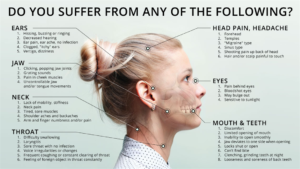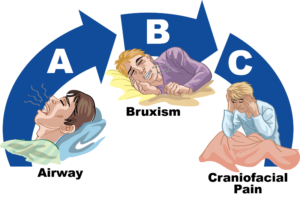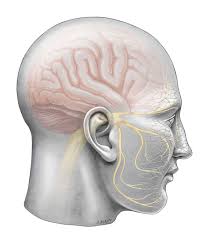Craniofacial pain is a term used to describe any chronic facial, neck or head pain. The most common forms of craniofacial pain are temporal mandibular joint dysfunction, trigeminal neuralgia and chronic headache disorder.

Temporomandibular joint disorder (TMD, aka TMJ) is pain or malfunction at the jaw joint. You may be more likely to get TMJ if you have rheumatoid arthritis, chronic fatigue syndrome, or fibromyalgia. Women are affected more often than men. Most people with TMJ are between the ages of 20 and 40. TMJ symptoms can include clicking, locking of the jaw, headache, earache, phantom tooth pain and facial muscle fatigue.
Trigeminal neuralgia is an ongoing pain condition that affects certain nerves in your face. Women are more likely than men to get trigeminal neuralgia, and the disorder is more common in people older than 50. Symptoms can include facial pain, difficulty in chewing, speaking, and brushing teeth.
Chronic headache disorder is a headache (Migraine, tension, or cluster) that occurs repeatedly. Tension-type headaches are the most common form of chronic headache disorder. A tension-type headache is generally described as a diffuse, mild to moderate pain or ache across the forehead, sides or back of your head or neck; a tight band-like feeling around your head; and sensitivity and/or tenderness of the scalp, neck and shoulders.
Migraines like tension-type headaches are also a very common form of chronic headache disorder. See previous newsletter on migraines for more details regarding symptoms and treatment options.
Cluster headaches are the least common type of chronic headache disorder affecting less than 1 in 1,000 people. This headache is of shorter duration but very painful, occurring daily for weeks or months at a time, then disappears completely to return without warning months or years later. Symptoms include severe pain in or around one eye that may radiate to your face, head, neck and shoulders; usually one-sided pain; restlessness; excessive tearing and redness in your eye on the affected side; nose congestion or runniness on the affected side; forehead or facial sweating; pale skin or flushing of the face; and swelling around the eye or drooping of the eyelid on the affected side.
There are many causes of craniofacial pain. Macro traumas, direct injury, to the face, jaw and neck that are caused by car accidents, sports injuries and accidental falls can result in craniofacial pain. Micro traumas, indirect injury occurring over time, from stress, poor sitting and standing postures, chronic grinding and/or clenching of the teeth, and sleep disorders (sleep apnea, snoring) can cause the muscles that help to stabilize the head, neck, and/or jaw to be over worked and become fatigued resulting in craniofacial pain.

Airway – Sleep disorders like sleep apnea or or snoring
Bruxism -grinding of the teeth
Craniofacial pain – a result of both airway and bruxism
Whatever the cause or symptoms, craniofacial pain should not be taken lightly. It can lead to depression, sleep deprivation, overuse of medication, and severely affect your activities of daily living.
If you are experiencing symptoms of craniofacial pain your physical therapist can help you determine the origin of your symptoms and initiate a treatment plan which would include manual therapy techniques to treat soft tissue and joint imbalances, modalities (ultrasound, electrical stimulation, cold laser) to decrease inflammation and exercises to improve your posture and head, neck and jaw alignment.
For more information on craniofacial pain please contact us at 619.260.0750 today.
